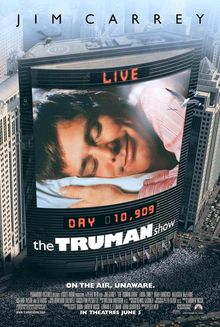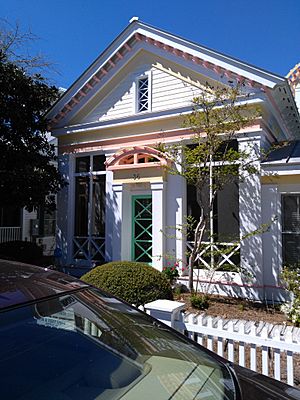The Truman Show facts for kids
Quick facts for kids The Truman Show |
|
|---|---|

Theatrical release poster
|
|
| Directed by | Peter Weir |
| Produced by |
|
| Written by | Andrew Niccol |
| Starring | |
| Music by |
|
| Cinematography | Peter Biziou |
| Editing by |
|
| Studio | Scott Rudin Productions |
| Distributed by | Paramount Pictures |
| Release date(s) | June 1, 1998 (Los Angeles) June 5, 1998 (United States) |
| Running time | 103 minutes |
| Country | United States |
| Language | English |
| Budget | $60 million |
| Money made | $264.1 million |
The Truman Show is a 1998 American comedy-drama movie. It is directed by Peter Weir and was written by Andrew Niccol. The main star of the movie is Jim Carrey. The movie is about a young man called Truman Burbank who lives in a fictional town called Seahaven. The whole town fits into a dome shape and Truman can be seen all over the world on television. He has been on the show since he was born. He was the one out of six unwanted babies to be in the show. He does not realise until later that the town he is living in is made-up. Christof is the creator of the show and some would call him a villain. He is in charge of making everything go right and cannot afford to lose Truman.
Contents
Cast
- Jim Carrey as Truman Burbank
- Chosen to be the first child legally adopted by a corporation, Truman is unaware that his daily life is broadcast continuously worldwide. He has a job in the insurance business and a wife, but he eventually notices that his environment is not what it seems to be. Robin Williams was considered for the role. Still, Weir cast Carrey after seeing him in Ace Ventura: Pet Detective because Carrey's performance reminded him of Charlie Chaplin. Carrey took the opportunity to proclaim himself as a dramatic actor, rather than being typecast in comedic roles. Carrey, who was then normally paid $20 million per film, agreed to do The Truman Show for $12 million. Carrey and Weir initially found working together on set difficult (Carrey's contract gave him the power to demand rewrites), but Weir was impressed with Carrey's improvisational skills, and the two became more interactive. The scene in which Truman declares "this planet Trumania of the Burbank galaxy" to the bathroom mirror was Carrey's idea.
- Laura Linney as Hannah Gill, acting as Meryl Burbank, Truman's wife
- A nurse at the local hospital. Since the show relies on product placement for revenue, Meryl regularly shows off various items that she has recently "purchased", one of the many oddities that makes Truman question his life. Her role is to act the part of Truman's wife and ultimately to have a child by him, despite her reluctance to accomplish either. She is written off the show after a heated argument with Truman, which is portrayed as a divorce. Linney heavily studied Sears catalogs from the 1950s to develop her character's poses.
- Ed Harris as Christof
- The creator of The Truman Show. Christof remains dedicated to the program at all costs, often overseeing and directing its course in person rather than through aides. Dennis Hopper was originally cast in the role, but he left in April 1997 (during filming) over "creative differences". Harris was a last-minute replacement. Hopper later stated that he was fired after two days because Weir and producer Scott Rudin had made a deal that if they did not both approve of Hopper's performance, they would replace him. A number of other actors had turned down the role after Hopper's departure. Harris considered making Christof a hunchback, but Weir did not like the idea.
- Noah Emmerich as Louis Coltrane, playing Marlon, Truman's best friend since early childhood
- Marlon is a vending machine operator for the company Goodies, who promises Truman that he would never lie to him, despite the latest events in Truman's life. Emmerich has said, "My character is in a lot of pain. He feels really guilty about deceiving Truman." Very little of this is shown in the finished film, but several deleted scenes depict Louis actively expressing guilt over Truman's situation, and in one sequence, he spots Truman during his escape and purposely says nothing. His name is an amalgamation of two jazz musicians, Louis Armstrong and John Coltrane, and in one scene, he plays the trumpet.
- Natascha McElhone as Sylvia, playing Lauren Garland, Truman's college schoolmate
- Sylvia was hired to play a background extra, a fellow student at Truman's college, named Lauren. Unlike the other actors who are in it to get paid, she actually believes that Truman should be free from his false reality rather than be locked up like an animal. She became romantically involved with Truman and tried to reveal the truth to him about his life, but was removed from the show before she could do so. She then becomes a protester against The Truman Show, urging Christof to release its lead.
- Holland Taylor as Alanis Montclair, playing Truman's mother Angela Burbank
- Brian Delate as Walter Moore, playing Truman's father Kirk Burbank
- Walter's character on The Truman Show—Truman's "father", Kirk—is "killed off" by Christof during Truman's childhood, supposedly dying in a rainstorm while the two are on a boat out at sea. This trauma is designed to instill a pathological fear of water that will keep Truman from escaping the show's set, an artificial indoor island. Walter later sneaks inside Seahaven to revive his career by disguising himself as an extra. After Truman spots him, his character is reintroduced on the show by using amnesia to explain his absence.
- Paul Giamatti as Simeon, a control room director
- Peter Krause as Laurence, Truman's boss
- Harry Shearer as Mike Michaelson, a TV talk-show host
- Philip Baker Hall as a Network Executive
- Joel McKinnon Miller as a garage attendant
Production

Andrew Niccol completed a one-page film treatment titled The Malcolm Show in May 1991. The original draft was more in tone of a science fiction thriller, with the story set in New York City. Niccol stated, "I think everyone questions the authenticity of their lives at certain points. It's like when kids ask if they're adopted." In the fall of 1993, producer Scott Rudin purchased the script for slightly over $1 million. Paramount Pictures agreed to distribute. Part of the deal called for Niccol to make his directing debut, though Paramount executives felt the estimated $80 million budget would be too high for him. In addition, Paramount wanted to go with an A-list director, paying Niccol extra money "to step aside". Brian De Palma was under negotiations to direct before he left United Talent Agency in March 1994. Directors who were considered after De Palma's departure included Tim Burton, Sam Raimi, Terry Gilliam, Barry Sonnenfeld and Steven Spielberg before Peter Weir signed on in early 1995, following a recommendation of Niccol. Bryan Singer wanted to direct but Paramount decided to go with the more experienced Weir.
Weir wanted the film to be funnier, feeling that Niccol's script was too dark, and declaring, "where [Niccol] had it depressing, I could make it light. It could convince audiences they could watch a show in this scope 24/7." Niccol wrote sixteen drafts of the script before Weir considered the script ready for filming. Later in 1995, Jim Carrey signed to star, but because of commitments with The Cable Guy and Liar Liar, he would not be ready to start filming for at least another year. Weir felt Carrey was perfect for the role and opted to wait for another year rather than recast the role. Niccol rewrote the script twelve times, while Weir created a fictionalized book about the show's history. He envisioned backstories for the characters and encouraged actors to do the same.
Weir scouted locations in Eastern Florida but was dissatisfied with the landscapes. Sound stages at Universal Studios were reserved for the story's setting of Seahaven before Weir's wife Wendy Stites introduced him to Seaside, Florida, a "master-planned community" located in the Florida Panhandle. Pre-production offices were immediately opened in Seaside, where the majority of filming took place. The scenes of Truman's house were filmed at a residence owned by the Gaetz family, which included Florida State Senator Don Gaetz and future U.S. representative Matt Gaetz. Other scenes were shot at Paramount Studios in Los Angeles, California. Norman Rockwell paintings and 1960s postcards were used as inspiration for the film's design. Weir, Peter Biziou and Dennis Gassner researched surveillance techniques for certain shots.
Filming took place from December 1996 to April 1998. The overall look was influenced by television images, particularly commercials: Many shots have characters leaning into the lens with their eyes wide open, and the interior scenes are heavily lit because Weir wanted to remind viewers that "in this world, everything was for sale". Those involved in visual effects work found the film somewhat difficult to make because 1997 was the year many visual effects companies were trying to convert to computer-generated imagery (CGI). CGI was used to create the upper halves of some of the larger buildings in the film's downtown set. Craig Barron, one of the effects supervisors, said that these digital models did not have to look as detailed and weathered as they normally would in a film because of the artificial look of the entire town, although they did imitate slight blemishes found in the physical buildings.
Themes
Media
"This was a dangerous film to make because it couldn't happen. How ironic."
In 2008, Popular Mechanics named The Truman Show as one of the 10 most prophetic science fiction films. Journalist Erik Sofge argued that the story reflects the falseness of reality television.
Ronald Bishop's paper in the Journal of Communication Enquiry suggests The Truman Show showcased the power of the media. Truman's life inspires audiences around the world, meaning their lives are controlled by his. Bishop commented, "In the end, the power of the media is affirmed rather than challenged. In the spirit of Antonio Gramsci's concept of hegemony, these films and television programs co-opt our enchantment (and disenchantment) with the media and sell it back to us."
Similarity to Utopia
Parallels can be drawn from Thomas More's 1516 book Utopia, in which More describes an island with only one entrance and only one exit. Only those who belonged to this island knew how to navigate their way through the treacherous openings safely and unharmed. This situation is similar to The Truman Show because there are limited entryways into the world that Truman knows. Truman does not belong to this utopia into which he has been implanted, and childhood trauma rendered him frightened of the prospect of ever leaving this small community. Utopian models of the past tended to be full of like-minded individuals who shared much in common, comparable to More's Utopia and real-life groups such as the Shakers and the Oneida Community. It is clear that the people in Truman's world are like-minded in their common effort to keep him oblivious to reality. The suburban "picket fence" appearance of the show's set is reminiscent of the "American Dream" of the 1950s. The "American Dream" concept in Truman's world serves as an attempt to keep him happy and ignorant.
See also
 In Spanish: The Truman Show para niños
In Spanish: The Truman Show para niños

